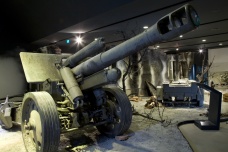The exhibition also includes multimedia elements. Eleven infokiosks allow visitors to search period photographs and documents. The text and pictorial material, as well as film documentaries, are screened on thirty plasma screens. One of these documentaries is a by filmmaker Evald Schorm, and was screened at the original exhibition. The centrepiece of the exhibition are the dioramas of military hardware and a house destroyed during fighting. The house was constructed on the basis of period photographs of the village of Hrabyně, which was destroyed during fighting and features authentic items donated by the village’s inhabitants.
The entrance to the exhibition takes the form of a memorial hall focussed its central object, a glass sarcophagus containing samples of earth from Second World War battlefields, concentration camps and other places that were witness to suffering. The memorial building includes a symbolic cemetery containing 13,000 plaques with the names of fallen Red Army soldiers, members of the 1st Czechoslovak Army Corps who fell during the Ostrava-Opava Offensive and the names of civilians from North Moravia and Silesia who fell during home resistance or perished in concentration camps. Beside the memorial are displayed several examples of historic military hardware. The smaller exhibition building contains space for seasonal exhibitions, a conference room, reading-room and restaurant.
Article last updated: 30.07.2012
Print whole article




